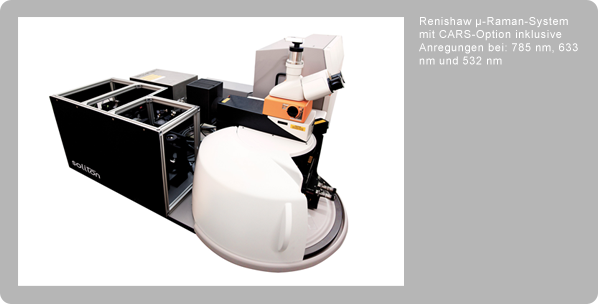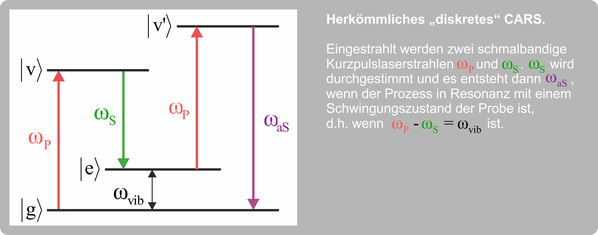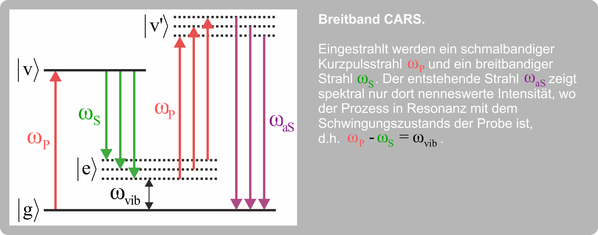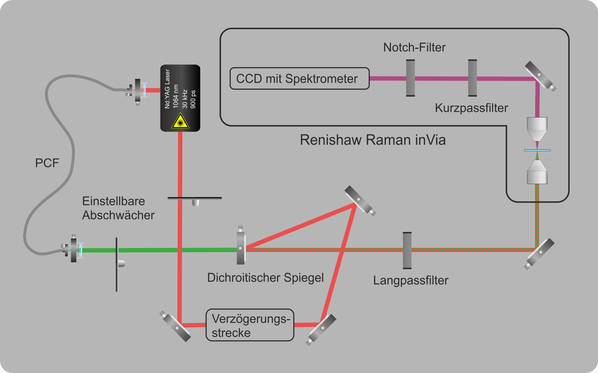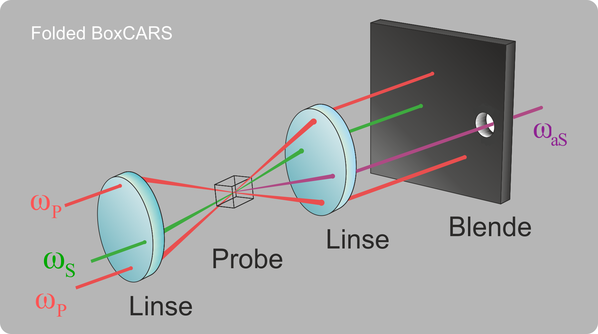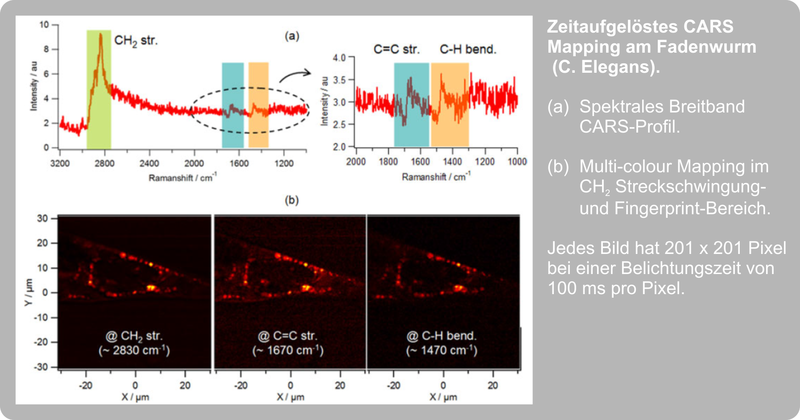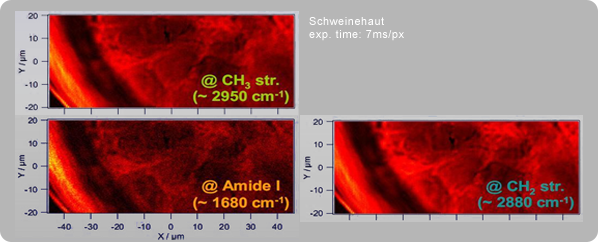(CARS)
CARS is a spectroscopy method that has been known for decades and has been used in particular to study combustion processes such as in engines and car engines. The CARS effect is a third-order nonlinear effect. Here two laser beams cross each other (pump beam ωP and Stokes beam ωS) in a medium and the Antistoke beam ωaS is generated. With this, the chemical structure, the temperature and the pressure can be determined based on the Raman selection rules.
Until now, these experiments have been complicated and required expensive fs laser arrays. Leukos has now developed a white light laser that enables the construction of cost-effective, easy-to-use and quickly adjustable broadband CARS systems.
The figure above shows the schematic structure of our CARS system, which is coupled to a high-performance Raman system from Renishaw. CARS is stimulated by a supercontinuum source from Leukos consisting of a sub-ns pulsed microChip laser (Nd:YAG @ 1064nm) and a photonic crystal fiber (PCF). Part of the beam goes into the PCF, which broadens the pulse spectrally to 400 to 2000 nm, using long-pass filters to block wavelengths <1064 nm that would otherwise overlap the anti-Stokes signal. The remaining long-wave component >1064 nm represents the broadband Stokes source. The narrow-band pump beam is irradiated into a delay path in order to compensate for the difference in path length of the PCF. The two beams are superimposed on each other using a dichroic mirror. However, these components could be used for other processes, such as stimulated Raman effect or stimulated CARS effect. The lens is used to focus on the sample and the CARS signal is generated in transmitted light. The light is collected with the lens of the 'Raman Renishaw inVia' and analyzed using the spectrometer and CCD of the Raman system.
In this way, the CARS signal passes through the same optical path as the Raman signal. A motorized change of the filter sets in the Raman system in seconds allows the user to carry out CARS and Raman measurements at the same location and almost at the same time. This allows a direct comparison of both methods to be made and a direct decision to be made as to which measurement method is more effective.
CARS versus Raman
Due to the nonlinearity, CARS measurements are significantly stronger than Raman measurements with comparatively similar parameters. This applies especially to strong Raman scatterers and to a limited extent to weak ones. The nonlinearity of the CARS effect also leads to higher local resolution, which is illustrated in the graphic below. With lenses with 20x magnification, CARS achieves a factor of ≈4 better depth resolution than with Raman, although the resolution shown here is limited by the sample structure. With suitable lenses, resolutions can be achieved that are well in the sub-μ range and are not subject to Abbe's resolution limitation.
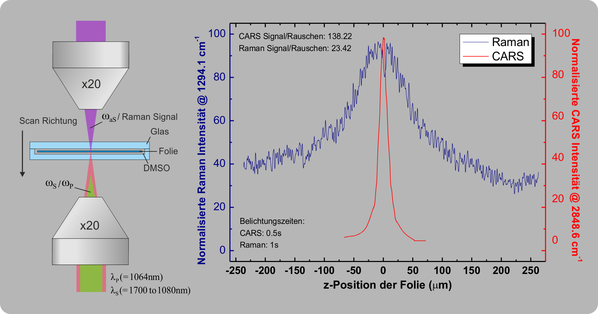
In addition, the anti-Stokes signal is blue-shifted and therefore shorter-wave than the irradiated lasers. In contrast to Raman, CARS eliminates disruptive fluorescence effects that would otherwise overlap with the signal. Through more intensive CARS signals, measurement times can be drastically reduced while the resolution is increased at the same time, allowing fast 2D and 3D mappings to be realized on dynamic processes, such as concentration measurements in microchannels.
A disadvantage, however, is the interference with a non-resonant background caused by non-resonant four-photon interaction, which changes the line shape and complicates the analysis of the spectra. This can be corrected by applying mathematical methods or experimentally using polarization techniques be suppressed.
Folded BoxCARS is particularly suitable for this, in which the pump jet is split into two jets. This leads to a further narrowing of the scattering volume due to the smaller overlap of the beams. With this method, even higher spatial resolutions can be achieved, allowing volumes in the attoliter range to be examined. Another advantage arises from the anti-Stokes beam being spatially separated from the other beams, which simplifies the spectral analysis regarding the choice of filters.
Because of the novel structure and the reduced costs, we see completely new possible applications in addition to the above-mentioned study of combustion processes:
- Shaping in biophysics (e.g. cell structure). (Advantage: fast mapping and no fluorescence)
- Study of rapid biophysical processes (e.g. observation of the death of cells down to the molecular structure)
- Analysis of materials from the environmental sector such as food, wood derivatives, dyes (e.g. in clothes) that cannot be directly measured by Raman because of their fluorescence.
- Analysis of nanoparticles that are too small for direct Raman measurements.
Not all of these new applications have already been implemented and we are eagerly awaiting interested parties who would like to get involved here.
We see a major advantage in the CARS integration into the high-quality Raman system, as research in these areas always requires good Raman spectra.
Downloads
